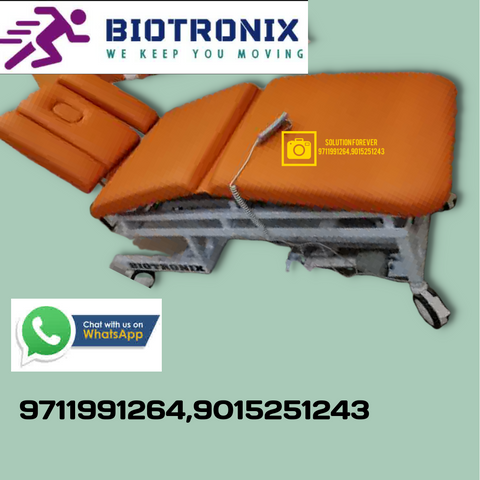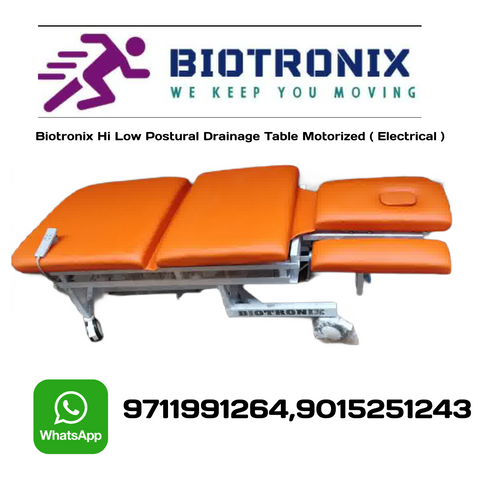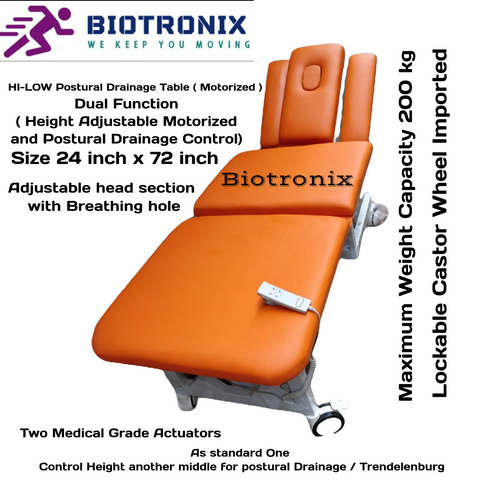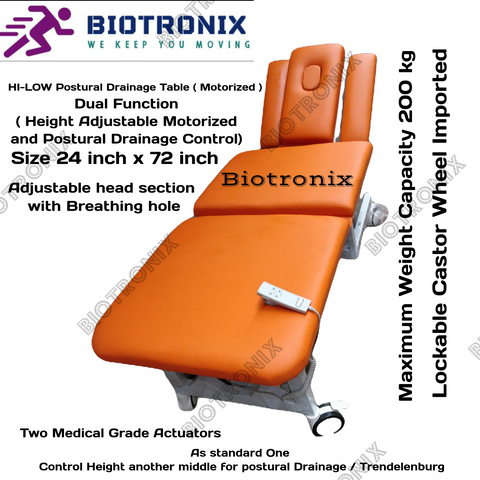Biotronix Multi Section ( 5 Section ) HI-LOW Postural Drainage Table ( Motorized ) Electrical Dual Function ( Height Adjustable Motorized and Postural Drainage Control) used in Physiotherapy and Rehabilitation
Biotronix Multi Section ( 5 section ) HI-LOW Postural Drainage Table ( Motorized ) Electrical Dual Function ( Height Adjustable Motorized and Postural Drainage Control) used in Physiotherapy and Rehabilitation
Product Specification
| Maximum Lifting Capacity | 200kg |
| Brand | Biotronix |
| Minimum Height | 20 inch |
| Maximum Height | 38 inch |
| Table Width | 24 inch |
| Table Length | 72 inch |
| Manual Headrest Adjustment | +40 deg to -90deg |
| Manual Leg Rest Adjustment | +70 |
| Minimum Order Quantity | 1 |
Specification
- Two Medical Grade Actuators (Imported / CE Certified)
- As standard One Control Height another middle for postural Drainage / Trendelenburg
- Adjustable head section with Breathing hole
- Motorized height adjustment as Standard
- Electric Flexion adjustment as standard
- Adjustable Backrest +70°, manual lever
- Breathing Hole for Prone Positioning
- Table Top Backrest cm, Middle section , Head section
- Available in Variable Sizes i.e. 24 inch x 72 inch
- Upholstery thickness, High Density Foam, soft & Durable Rexene
- Loading Weight 200 Kg / Net Weight 85- 90 Kg
- Lockable Castor Wheel Imported
- CE Certified Product
Specifications and Features :
- 5-Section table can be adjusted to a patient use
- Easy to use bar control from all the sides to raise or lower the table
- Heavy duty steel frame
- Semi-Firm Foam with Rexene Cover
- Smooth, reliable electric lift operation
- Lockable 4-wheels for easy transportation and stationary
- Size: 24″W x 72″L x 20-38″H
- Working capacity: 200 kg
- Headrest adjustment: lowered to 40°, raised up to 90°
- Backrest adjustment: raised up to 70°
- Middle section tilt up to 40 degree
- Elevation armrest manual
Package Contents:
- 1 pc Biotronix Multi Section ( 5 section ) HI-LOW Postural Drainage Table ( Motorized ) Electrical Dual Function ( Height Adjustable Motorized and Postural Drainage Control) used in Physiotherapy and Rehabilitation
- 1 Hand Remote Control
- 1 Complementary Physio Chart Set ( 6 wall pasted physio charts )
Warranty Details : 3 Year Motor Warranty against manufacturing Defect.















Postural Drainage
Introduction
The term chest physiotherapy (CPT) stands for a spectrum of physical and mechanical interventions aimed at interacting therapeutically with acute and chronic respiratory disorders.[1]Among various techniques for airway clearance, postural drainage is one of the widely used methods since decades.
Definition
Postural drainage is the positioning of a patient with an involved lung segment such that gravity has a maximal effect of facilitating the drainage of broncho-pulmonary secretions from the tracheobronchial tree.[2]It is based on the concept of gravity-assisted mobilization of secretions and transport it for removal. It is a positioning technique to mobilize bronchial secretions.


Mechanism
During erect position only the segments of the right upper lobe and non-lingular portion of the left upper lobe receive gravitational assistance whereas the segment of the middle, lingular portion of left upper lobe and lower lobe segments of both lungs must drain against gravity. In normal healthy state, the mucociliary mechanism clears off the bronchial secretions. In diseased state they get compromised and secretions get accumulated especially in the smaller airways that cannot be emptied without gravity assistance which can further lead to inflammation and scarring.[3]The natural methods of emptying the tracheo-bronchial tree of accumulated secretion are on the whole extremely inefficient. Ciliary action -only removes minute particulate matter such as dust or bacteria, and is of no value when there is much secretion.[4]
Procedure
The patient is tilted or propped at an angle required and chest percussion is performed to loosen the secretions. Frames, tilt tables, and pillows may be used to support patients in these positions.[1] There are postural beds that have a hinge in the middle.
In general, the upper lobe segments have the advantage of gravity drainage both in erect as well as in semi recumbent position, so postural drainage can be facilitated in sitting or lying posture. The middle and lower lobes do not have the advantage of gravity drainage in erect, semi-recumbent or recumbent postures.
A foot end elevation of 14-18 inches is requires for the drainage of middle and lower lobes. Each position consists of placing the target lung segment(s) superior to the carina. Positions should generally be held for 3 to 15 minutes (longer in special situations). Standard positions are modified as the patient's condition and tolerance warrant.

In critical care patients, including those on mechanical ventilation, Postural Drainage should be performed from every 4 to every 6 hours as indicated. PDT order should be re-evaluated at least every 48 hours based on assessments from individual treatments. Domiciliary patients should be reevaluated every 3 months and with change of status. . In the actively cooperating patient, postural drainage can be complemented by thoracic expansion exercises and by breathing control.
Positions
Upper Lobe
APICAL SEGMENTS -The patient should sit upright, with slight variations according to the position of the lesion which may necessitate leaning slightly j backward, forward or sideways. The position is usually only necessary for infants or patients being nursed in a recumbent j position, but occasionally may be required if there is an abscess or stenosis of a bronchus in the apical region.
ANTERIOR SEGMENTS - The patient should lie flat on his back with his arms relaxed to his side; the knees should be slightly flexed over a pillow.
POSTERIOR SEGMENT
- Right - The patient should lie on his left side and then turn 450 on to his face, resting against a pillow with another supporting his head. He r should place his left arm comfortably behind his back with his right arm resting on the supporting pillow; the right knee should be flexed.
- Left - The patient should lie on his right side turned 450 on to his face with three pillows arranged to raise the shoulder 30cm (i2in) from the bed. He should place his right arm behind his back with his left arm resting on the supporting pillows; both the knees should be slightly bent.

Middle Lobe
LATERAL SEGMENT: MEDIAL SEGMENT The patient should lie on his back with his body quarter turned to the left maintained by a pillow under the right side from shoulder to hip and the arms relaxed by his side; the foot of the bed should be raised 35cm (14in) from the ground. The chest is tilted to an angle of 15°.
Lingula
SUPERIOR SEGMENT: INFERIOR SEGMENT - The patient should lie on his back with his body quarter turned to the right maintained by a pillow under the left side from shoulder to hip and the arms relaxed by his side; the foot of the bed should be raised 35cm (14m) from the ground. The chest is tilted to an angle of 15°.

Lower Lobe
APICAL SEGMENTS - The patient should lie prone with the head turned to one side, his arms relaxed in a comfortable position by the side of the head and a pillow under his hips.
ANTERIOR BASAL SEGMENTS - The patient should lie flat on his back with the buttocks resting on a pillow and the knees bent; the foot of the bed should be raised 46cm (i8in) from the ground. The chest is tilted to an angle of 20°
POSTERIOR BASAL SEGMENTS - The patient should lie prone with his head turned to one side, his arms in a comfortable position by the side of the head and a pillow under his hips. The foot of the bed should be raised 46cm (i8in) from the ground. The chest is tilted to an angle of 20°.
MEDIAL BASAL (CARDIAC) SEGMENT - The patient should lie on his right side with a pillow under the hips and the foot of the bed should be raised 46cm (i8in) from the ground. The chest is tilted to an angle of 20°.
LATERAL BASAL SEGMENT - The patient should lie on the opposite side with a pillow under the hips and the foot of the bed should be raised 46cm (i8in) from the ground. The chest is tilted to an angle of 20°.

Assessment
The following should be assessed and reported to establish a need for postural drainage
- A recent radiograph or bronchogram if available, is a useful adjunct in isolating the affected areas.
- Pulmonary Function Test
- excessive sputum production
- effectiveness of cough
- history of pulmonary problems treated successfully with PDT (e.g., bronchiectasis, cystic fibrosis, Lung Abscess)
- decreased breath sounds or crackles or rhonchi suggesting secretions in the airway
- change in vital signs
- Abnormal chest x-ray consistent with atelectasis, mucus plugging, or infiltrates
- deterioration in arterial blood gas values or oxygen saturation

Indications
The following are the indications for postural drainage[5]:-
- evidence or suggestion of difficulty with secretion clearance
- difficulty clearing secretions with expectorated sputum production greater than 25-30 mL/day (adult)
- evidence or suggestion of retained secretions in the presence of an artificial airway
- presence of atelectasis caused by or suspected of being caused by mucus plugging
- diagnosis of diseases such as cystic fibrosis, bronchiectasis or cavitating lung disease
- presence of foreign body in airway

What is postural drainage?
Postural drainage sounds complicated, but it’s really just a way to use gravity to drain mucus out of your lungs by changing positions. It’s used to treat a variety of conditions, including chronic diseases such as cystic fibrosis and bronchiectasis, as well as temporary infections, such as pneumonia.
If you have a bad cold or flu, you can also use postural drainage to help keep mucus out of your lungs. The goal is to move mucus into the central airway, where it can be coughed up. It’s safe for people of all ages and can be done either at home or in a hospital or nursing facility.
Postural drainage is often done at the same time as percussion, sometimes called clapping, which involves someone clapping on your back, chest, or sides with a cupped hand in order to shake mucus loose from the lungs. These techniques, along with vibration, deep breathing, and huffing and coughing, are referred to as chest physiotherapy, chest physical therapy, or airway clearance therapy.

You can do postural drainage with many positions, either on your own or with a physical therapist or nurse.
General guidelines
- Each position should be held for a minimum of five minutes.
- Positions can be done on a bed or on the floor.
- In each position, your chest should be lower than your hips to allow mucus to drain.
- Use pillows, foam wedges, and other devices to make yourself as comfortable as possible.
- While in the positions, try to breathe in through your nose and out through your mouth for longer than you breathe in for maximum effectiveness.
- Do these positions in the morning to clear mucus that’s built up overnight or right before bed to prevent coughing during the night.
A respiratory therapist, nurse, or doctor can recommend the best ways to perform postural drainage based on where the mucus is.
On your back
- Your chest should be lower than your hips, which you can achieve by lying on a slanted surface or propping your hips up about 18 to 20 inches with pillows or another item.
- This position is best for draining the bottom front parts of your lungs.

What is Postural Drainage?
It is a form of Airway Clearance Therapy that involves placing the patient’s body in various positions in order to drain secretions from the lung segments into the central airways using gravity. From there, the secretions can be removed via cough or suctioning.

Postural Drainage Positions:
The following tables break down every Postural Drainage Position that is needed in order to drain each specific lobe or segment of the lungs.
|
Posterior Segment |
|
|
Apical Segment |
|
|
Anterior Segment |
|
|
Right Middle and Left Lingual |
|
|
Right Lateral and Medial Segments |
|
|
Left Superior and Inferior Lingual Segments |
|
|
Lower Lobes |
|
|
Posterior Basal Segment |
|
|
Lateral Basal Segment |
|
|
Anterior Basal Segment |
|
|
Superior Segment |
|

Postural Drainage Indications:
- To mobilize retained secretions so that they can be suctioned or expectorated
- Cystic Fibrosis
- Atelectasis
- Bronchiectasis
- Foreign body obstruction

Postural Drainage Contraindications:
There are certain situations in which Postural Drainage would not be recommended. Here are some examples:
- Head, neck, or spinal injury
- Hemodynamic instability
- Increased intracranial pressure
- Hemoptysis
- Bronchopleural fistula
- Pulmonary edema as a result of CHF
- Pleural effusion
- Flail Chest

Is Postural Drainage Used to Treat Cystic Fibrosis?
Yes, Postural Drainage is an effective method that is used to treat patients with Cystic Fibrosis.
With that said, other forms of Airway Clearance Therapy can be used as well and no one method has been proven to be more effective than others. It all depends on the patient’s preference. In general, you should select the method that will be most tolerated by the patient.
What is postural drainage?
Postural drainage is a technique used to mobilise large amounts of secretions in people with respiratory conditions. Postural drainage relies on the effects of gravity to drain the secretions (phlegm) from one or more lung segments into the central airways where it can be removed via huffing or coughing techniques.

What are the benefits of postural drainage?
Postural drainage has a number of benefits for patients, these include:
- Removal of secretions minimises the risk of developing a chest infection
- Can also help improve respiratory function
- Can be used in combination with manual physiotherapy techniques
- Coherent patients can use principles themselves to gain benefits within their homes
- Requires little active involvement from patient
- Less invasive than manual respiratory physiotherapy techniques

Who would benefit from postural drainage?
Postural drainage will be beneficial for many patients suffering from respiratory condition in which excessive secretions are present. These conditions may include: The technique is particularly beneficial in patients unable to co-operate with active breathing techniques, as it requires little input from the patient.
Contradictions
HEMORRHAGE (SEVERE HEMOPTYSIS)
- NOTE: This is different from lightly blood–streaked sputum
- Copious amounts of blood in the sputum
UNTREATED ACUTE CONDITIONS
- Severe pulmonary edema
- Congestive heart failure
- Large pleural effusion
- Pulmonary embolism
- Pneumothorax
Cardiovascular Instability
- Cardiac arrhythmia
- Severe hypertension or hypotension
- Recent myocardial infarction
Recent Neurosurgery
- Head-down position may cause increased intracranial pressure.

Physiotherapy Techniques
In addition to the use of body positioning, deep breathing and effective cough to facilitate clearance of secretions from the airways, a variety of manual techniques are used in conjunction with postural drainage to maximize the effectiveness of the mucociliary transport system. They include:
Postural Drainage Positions
Positions are based on the anatomy of the lungs and the tracheobronchial tree.
The patient may be positioned on a:
- Postural drainage table that can be elevated at one side
- Tilt table
- Reinforced padded table with a lift
- Hospital bed

Percussion
- This technique is used to further mobilize secretions by mechanically dislodging viscous or adherent mucus from the lungs.
- Percussion is performed with cupped hands over the lung segment being drained. The therapist’s cupped hands alternately strike the patient’s chest wall in a rhythmic fashion. The therapist should try to keep shoulders, elbows, and wrists loose and mobile during the maneuver. Mechanical percussion is an alternative to manual percussion techniques.
- Percussion is continued for several minutes or until the patient needs to alter position to cough.
- This procedure should not be painful or uncomfortable. To prevent irritation to sensitive skin, have the patient wear a lightweight gown or shirt. Avoid percussion over breast tissue in women and over bony prominences.

Postural Drainage and Percussion
Postural drainage and percussion (PD&P) are often used together to help clear the lungs and airway in cystic fibrosis (CF).
Postural drainage uses gravity to drain thick, sticky mucus. It moves the mucus from the small airways of the lungs to the large airways where it can be coughed up and spit out. This is done by placing the body in different positions. Each position drains a different area (segment or lobe) of the lung.
Chest percussion uses clapping of the chest using a cupped hand. This vibrates the airways of the lungs. The vibration on the chest helps to move and break apart the mucus inside the lungs. Chest percussion may be performed using a device called a mechanical percussor.
Postural drainage and percussion (PD&P) uses both gravity and percussion to loosen thick, sticky mucus from the airways. Once loose, the mucus can be removed by coughing. Unclogging the airways and lungs is important to decrease the chance of lung infection.
Why do we do PD&P?
For those with cystic fibrosis, postural drainage and percussion is done to help keep the airways as clean as possible. This makes breathing easier. PD&P might decrease the risk of lung infection by helping to keep the lungs clear of thick mucus.

Both postural drainage and percussion are considered chest physical therapy (or chest physiotherapy, CPT). Additional CPT techniques include:
- Vibration, a technique that gently shakes the mucus. This moves the mucus in the airway in order to spit it out. Instead of using a cupped hand technique, a flat hand is used. Once the hand is flat on the chest, the caregiver squeezes the muscles of the arm and shoulder. This causes a fine vibration motion.
- Deep breathing helps to expand the lungs and may cause coughing. This is helpful when trying to remove mucus from the lungs.
- Coughing is an important part of keeping the airway clear. Coughing happens with a forced release of air. If you are able to, sitting in an upright position might help.
- Huffing, or huff coughing, is vigorous coughing. This is done at the end of PD&P to get more mucus out of the lungs.
Tips, tricks, and resources
Postural drainage and percussion is easy to do and can be done by anyone, including parents, siblings, and friends. These tips, tricks, and resources may help.2
Before starting
Mucus should be as thin as possible for PD&P to work best. This helps to cough and clear mucus out of the airway. To help thin mucus, be sure to drink enough fluids.2
If you use a bronchodilator, PD&P should be done after the bronchodilator has started to work. Talk to your doctor about when is best for you, as this may be different for everyone.
Equipment
Various equipment is available for PD&P, including mechanical percussors and drainage tables. Talk to your doctor about your needs. A medical supply company can supply this equipment. Your insurance company may cover these supplies.


Products Tags and Keywords :
Postural Drainage Table ,Hi low Postural Drainage Table ,Hi low Treatment table ,postural drainage concept ,postural drainage table motorized , Tables, Treatment Tables , physiotherapy table, PT Ultra 5-Section Examination Table , Postural Drainage, PT Ultra 5-Section Physio Table , Postural Drainage






























































































